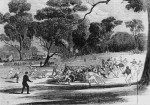Yarra Park, from Go to Woe
When Charles Joseph La Trobe arrived in Melbourne in 1839 as the newly appointed superintendent of the colony of Port Phillip he would have found the north bank of the Yarra, just east of the city, to be bordered by swamps and lagoons rising gently to open scrubland dominated by large river red gums. He would have seen aborigines from the local Wurundjeri clan hunting and fishing in the lagoons; and occasionally he might have seen a corroborree as neighbouring clans joined them in celebration.
He immediately recognised the potential of the area for recreational use and proposed that approximately 240 acres stretching, in modern terms, from Punt Road to Princes Bridge, and northwards to Wellington Parade and Flinders Street, be reserved for that purpose. However it was not until 1873 that this visionary proposal was ratified by an Act of Parliament. By then the original 240 acres had suffered several excisions.
La Trobe, himself, made the first cut when he bought his Jolimont land in 1840. Next, in 1853, the Melbourne Cricket Ground was given permissive occupancy of nine acres which was formally recognised as a Crown Grant in 1867.
 1866 Richmond Paddock
1866 Richmond Paddock
Australian football matchIn 1858 the first game of Australian Rules Football was played in Richmond Paddock, or Yarra Park, between Scotch College and Melbourne Gammar. However it was many years before the game was allowed to be played at the MCG as its turf was considered too delicate for the rough and tumble of the new game.
A stand built at the MCG in 1876 was reversible which could be made to face the MCG in summer for cricket, or the Richmond Paddock in winter for football. It burnt down in 1884.
In 1859 the railway line to Richmond effectively cut the park in half lengthways. In the same year land was reserved for the Swan Street extension, although it was not built until 1875. Thirty three acres to the south of this was given to the Acclimatisation Society which gave way to the Friendly Society Gardens when the animals were moved to Royal Park two years later as the start of the Zoo. Now that area is Olympic Park.
The Acclimatisation Society was linked to the Botanical Gardens by a foot bridge over the Yarra, and passengers on the Richmond line were once able to alight at the Botanical Gardens Railway Station, and from there it was just a short walk to either destination. The old railway bridge in Yarra Park, although much lengthened now, is a relic of those days. The land on the corner of Punt Road and Wellington Parade, which had once been the police barracks and gaol, was also excluded from the grant. A section of it was granted separately for a state school. The remainder was subdivided into 83 residential allotments and sold in 1881.
The remaining land when it was finally reserved in 1873 was gazetted as two parks, one each side of Jolimont Road, which then ran to the river and Branders’ ferry. Flinders Park was to the west, replacing the Police Magistrate’s Paddock where Captain Lonsdale had built his cottage; and Yarra Park to the east, replacing the old Police, or Government, Paddock, also known as the Richmond Paddock, where the police horses had once grazed. Yarra Park also included the parcel of land to the south of Swan Street known as Gosch’s Paddock.
Modern encroachments have reduced the size of the park even further. The MCG’s girth has expanded considerably. And the tennis centre, or Melbourne Park, once called Flinders Park because that is where it was, has slipped into Yarra Park with the building of the Vodaphone Arena in 2000.
The 1956 Olympic Games marked the beginning of Yarra Park’s degradation. This was the first time visitors to the MCG had been allowed to park their cars in the park proper. Previously parking had been limited to the corner formed by Brunton Avenue and Jolimont Street. The Council was very pleased with this clever solution and has never looked back, and except, ironically, for the hugely successful banning of car parking during the 2006 Commonwealth Games, cars now fill Yarra Park every time the MCG is used. The result is bare, compacted earth and suffering trees; a far cry from the thriving natural environment La Trobe hoped to bequeath to the citizens of Melbourne for their recreation and pleasure.
